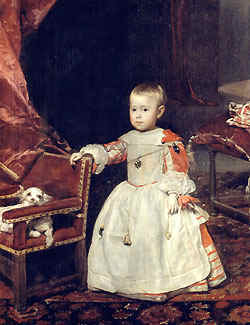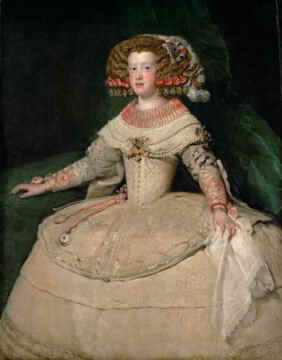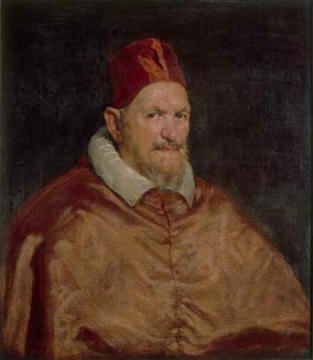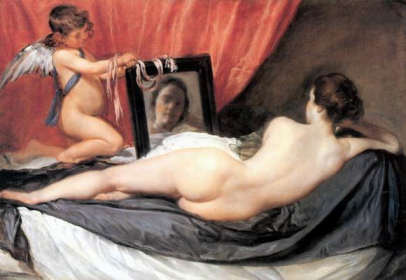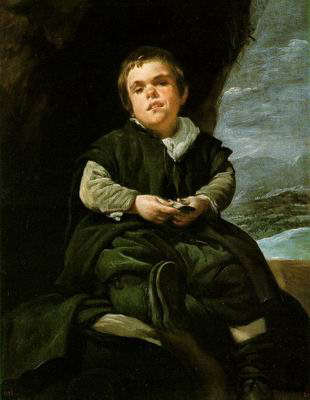|
Editorial Board
Melanie
Eskenazi
Webmaster: Len Mullenger
|
Seen and Heard Art Review
Velásquez: National Gallery, London. Until 21 January 2007 Sponsored by Abbey (AR)
Velásquez and The Shining of Time
“Lighting bestows the shining, opens what shines to an appearance. The open is the realm of unconcealment and is governed by disclosure. The lighting not only illuminates what is present, but gathers it together and secures it in advance in presencing.”
Heidegger, Aletheia: Heraclitus Fragment.
“Only
by virtue of light, through brightness, can what shines
show itself, that is radiate. But brightness in its turn
rests upon something open, something free, which might
illuminate it here and there, now and then. Brightness,
in the form of lightning, plays in the open and wars there
with darkness.” Heidegger,
The End of Philosophy.
Eduard Manet rightly described Diego Rodriguez de Silva y Velásquez (1599-1660) as "the painters' painter". I would also describe him as "the philosophers’ painter” - Velásquez is the painter of the sensation of time passing - before being a painter of people per se: for time gives space and light for being to be there. Velásquez’ extraordinarily light, subtle and fleeting use of paint gives light to shine time through.
With Velásquez’ shimmering paint there
is the sense of time passing where his subjects
become revenants: those that return and come back to haunt
us – and this is seen in his later works: Queen Mariana
of Austria (1652), The Infanta Margarita in a Blue
Dress (1659), The Infanta María Teresa,(1653)
and
The Infante Felipe Próspero with a Dog (1659).
Here is a haunting sensation of time going to work and
doing its thing through the flickers of paint – those
tears of time.
The
skin textures are painted with a feather-light touch and
glow with a radiant translucency – just like in The
Toilet of Venus (1647-51) – his only known nude and
the greatest nude in Western art - and one wonders why
heavy handed painters like Lucien Freud and Frank Auerbach
never learnt from their master – for both fail to fathom
that skin is pearly, translucent and multi-coloured –
not yellow ochre and burnt umber. Velásquez’ use of paint
is far more intense, real, radical and revealing than
that of Freud or Auerbach, or even mud merchants Jenny
Saville and Cecily Brown. For Velásquez skin is the shining
of time passing by as a lighting of being there for a
time: skin is the connecting and coming together of being
and time through light.
The Dwarf
Francisco Lezcano
(1642-45)
also has a serene skin sensation that shimmers with compassion and respect, and
this is one of Velásquez’ most touching and poignant portraits yet without a
hint of kitsch sentimentality or political correctness.
As this
once in a lifetime exhibition has become a sell-out, advance booking is vital to
guarantee the day and time of your choice – either way do not miss this life
enhancing experience.
National
Gallery exhibition catalogue title: Velásquez: Authors:
Dawn Carr, Xavier Bray, John H. Elliott, Larry Keith and
Javier Portus. 224 pages, 172 colour illustrations: hard
back: £35 paper back: £19.95. ISBN: 1857093038 Publisher:
National Gallery Co Ltd.
This
Exhibition Catalogue explores and contextualises the artist's work and discusses
his influence. Written by world-class Velázquez scholars, the book surveys the
artist's entire career, from his studies in Seville and Italy to his final great
works at the court of Philip IV. It includes a full catalogue and chronology.
Alex
Russell
Back to the Top Back to the Index Page |
| ||
|
||||



